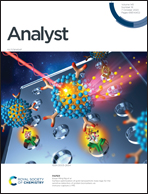Fluorescence nucleobase analogue-based strategy with high signal-to-noise ratio for ultrasensitive detection of food poisoning bacteria†
Abstract
We developed a simple and ultrasensitive strategy for the identification of foodborne pathogens utilizing a fluorescent nucleobase analogue [2-aminopurine (2-AP)]-containing split G-quadruplex that binds blocker DNA. Compared to a previous strategy that did not use blocker DNA, this strategy showed a significant increase in the signal-to-noise ratio—by approximately 300%—owing to the displacement of the blocker DNA by the target DNA that induces the formation of an active G-quadruplex structure, thereby leading to a substantial increase in the 2-AP fluorescence signal. The proposed strategy was rationally combined with polymerase chain reaction, which resulted in the successful determination of genomic DNA (within the range of 10–106 copies) derived from the food poisoning bacterium Escherichia coli, with a limit of detection of 5.2 copies and high selectivity. In addition, the practical applicability of this method was demonstrated by analyzing E. coli-spiked lettuce samples.



 Please wait while we load your content...
Please wait while we load your content...